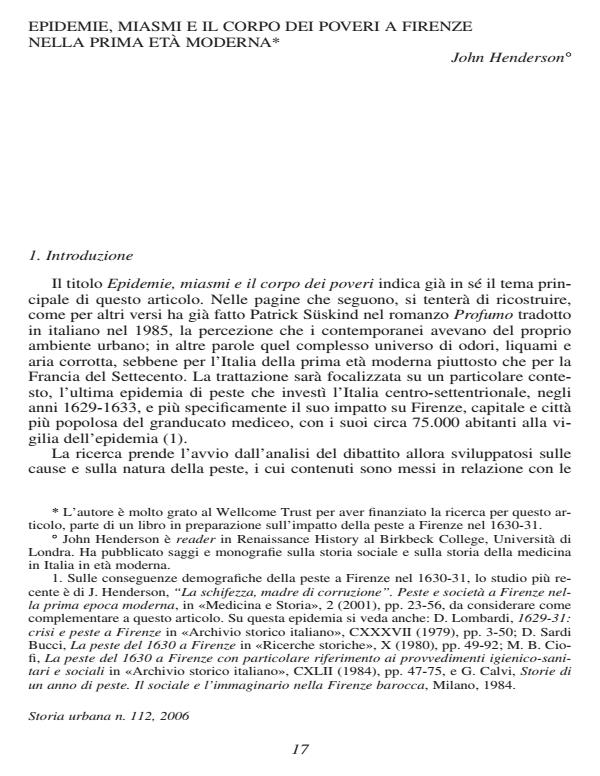Epidemie, miasmi e il corpo dei poveri a Firenze nella prima età moderna
Titolo Rivista STORIA URBANA
Autori/Curatori John Henderson
Anno di pubblicazione 2007 Fascicolo 2006/112
Lingua Italiano Numero pagine 21 P. 17-37 Dimensione file 110 KB
DOI
Il DOI è il codice a barre della proprietà intellettuale: per saperne di più
clicca qui
Qui sotto puoi vedere in anteprima la prima pagina di questo articolo.
Se questo articolo ti interessa, lo puoi acquistare (e scaricare in formato pdf) seguendo le facili indicazioni per acquistare il download credit. Acquista Download Credits per scaricare questo Articolo in formato PDF

FrancoAngeli è membro della Publishers International Linking Association, Inc (PILA)associazione indipendente e non profit per facilitare (attraverso i servizi tecnologici implementati da CrossRef.org) l’accesso degli studiosi ai contenuti digitali nelle pubblicazioni professionali e scientifiche
This article examines contemporary understanding of the cause and nature of plague and secondly relate this to the developing measures taken by the government of Florence during the last outbreak to affect the city in 1630-31. The idea of corrupt air, putrefaction and smell underlines these themes, but they also served to underline contemporary perceptions of the poor who were seen as the main source of disease. Inevitably the danger in examining plague through the eyes of governments is that this leads to a very one-sided version of events; those at the lower end of the social scale are lumped together under the heading of «the poor». While the article concentrates largely on the relationship between medical theory and government policy, by examining four main types of plague «narrative», it endeavours to clarify the identity of «the poor» and examine their reactions during the plague. The first plague «narrative» is the official account written by the librarian of the Grand-duke of Tuscany, Ferdinand II. This is compared with the narrative of events as recorded in the deliberations and regulations of the Sanità, the health board responsible for the day-to day campaign against this «invisible enemy». The rationale behind these measures will then be examined, and in particular the relationship between the demands of public order and the contemporary understanding of the nature of plague as recorded in the texts written by contemporary physicians who advises the government. Finally, some idea will be provided about the identity and reactions of the poor through the events narrated in the Sanità’s court records. These trials throw a surprising amount of light on the reactions of the poorer members of society and enable one to talk in more specific terms about the motivation for their actions within the context of their understanding of plague.
John Henderson, Epidemie, miasmi e il corpo dei poveri a Firenze nella prima età moderna in "STORIA URBANA " 112/2006, pp 17-37, DOI: